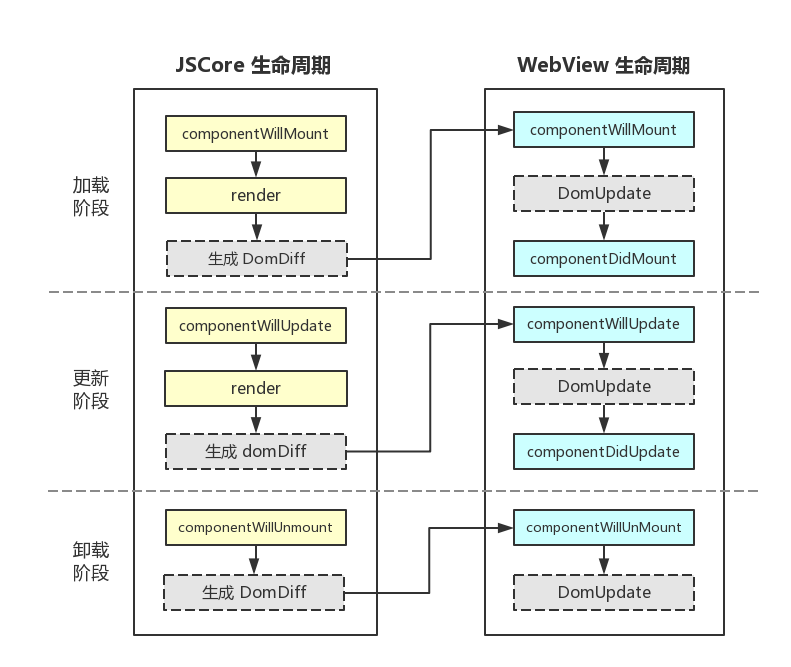组件生命周期
我们再来回顾一下 组件运行机制 介绍里的这张图。

其中,黄色部分是 JSCore 中组件 Component 的生命周期,蓝色部分是 WebView 中组件 UIComponent 的生命周期。本结将列出这些回调的详细信息。
Component
Component 的生命周期可以参考 React,在此不一一列出。
- constructor
- componentWillMount
- componentWillReceiveProps
- shouldComponentUpdate
- componentWillUpdate
- componentWillUnmount
UIComponent
UIComponent 中一个很重要的参数是 vnode(虚拟 dom)。它是 Component 向 UIComponent 输出的结构单元。所以我们先来介绍一下 vnode 的数据结构。
{
attrs: { // 写在标签上的属性
componentType, // 组件类型(即:组件类型唯一标识)
componentId // 组件 id
},
dom, // 真实 dom 元素
mounted, // 是否渲染过
order, // 在父元素中的顺序
vChildren, // 子组件虚拟 dom
vParent // 父虚拟 dom
}
constructor
| 参数属性 | 说明 | 例子 |
|---|---|---|
| props | jsCore 传递过来的 wv- 前缀的参数,以及组件 id |
{ id: 3, test: testparam, count: 1 } |
componentWillMount
该函数接受一个 bollean 类型的返回值,如果返回 true, YIS 不会执行节点的挂在,开发者可以手动挂载节点到目标容器,该场景主要用于处理动画。
| 参数属性 | 说明 | 例子 |
|---|---|---|
| vnode | 虚拟 dom | 参考上文 |
代码节选自:yis-demo/src/components/test/browser.js
@YISComponent.UI('Test')
export default class Test extends UIComponent {
//......
componentWillMount({vnode}) {
vnode.dom.innerText = vnode.dom.innerText + '重写后';
vnode
.vParent
.dom
.appendChild(vnode.dom);
return true;
}
//......
}
componentDidMount
| 参数属性 | 说明 | 例子 |
|---|---|---|
| props | jsCore 传递过来的 wv- 前缀的参数,以及组件 id |
{ id: 3, test: testparam } |
| vnode | 虚拟 dom | 参考上文 |
componentWillUpdate
| 参数属性 | 说明 | 例子 |
|---|---|---|
| nextProps | 变化了的 wv- 前缀的参数 |
{count: 2 } |
| vnode | 虚拟 dom | 参考上文 |
componentDidUpdate
| 参数属性 | 说明 | 例子 |
|---|---|---|
| props | 变化了的 wv- 前缀的参数 |
{count: 2 } |
| vnode | 虚拟 dom | 参考上文 |
componentWillUnmount
| 参数属性 | 说明 | 例子 |
|---|---|---|
| vnode | 虚拟 dom | 参考上文 |
该函数接受一个 bollean 类型的返回值,如果返回 true, YIS 不会执行节点的挂在,开发者可以手动从目标容器卸载节点,该场景主要用于处理动画。
代码节选自:yis-demo/src/components/test/browser.js
@YISComponent.UI('Test')
export default class Test extends UIComponent {
//......
componentWillUnmount({vnode}) {
console.log('componentWillUnmount', arguments);
window.setTimeout(() => {
vnode
.vParent
.dom
.removeChild(vnode.dom);
}, 3000);
return true;
}
}